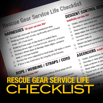Guidelines for Permanent Marking of Rescue Hardware
One of the most reliable ways to ensure that your rescue team is able to identify, and if needed, prove ownership of its equipment is by marking the gear with some type of visible identification. There are many ways to accomplish this ranging from color-coded paint or vinyl tape to affixing tags. Each has its shortcomings in terms of durability – and tags could potentially interfere with the function of the item. Here are some additional guidelines from our hardware manufacturer, SMC. For more than 40 years, it has been SMC’s goal to design and manufacture innovative gear that sets the standard for quality, reliability, and functionality.
The following information is intended to serve as a clear and simple guide concerning what is acceptable and conversely, what is not acceptable, when permanently marking by engraving into the surface of various types of hardware. Note: Always adhere to your equipment manufacturer’s instructions.
First of all, it’s very important to note that it is only acceptable to use a “hand-held” electric type engraver to place identifying marks on hardware. Do NOT strike with a hammer or stamps or ever use other similar methods. Once the marking process has been completed, ALWAYS inspect the product for proper fit and function PRIOR to returning it to service.
Carabiners:
For carabiners, it is recommended to mark along the spine of the frame. Do NOT mark on or near the lock or pivot tabs of the frame and stay away from rope bearing areas. Do NOT mark on the gate! For steel and stainless products, use a medium setting with medium to heavy pressure. For aluminum products, use a low setting with light to medium pressure. Depth of engraving equal to the thickness of a piece of paper should be enough to last the life of the product.
Pulleys:
For pulleys, it is recommended to mark on the flat outside surface around the axle. Do NOT mark ON OR NEAR the carabiner hole at the top of a pulley or anywhere on the becket of a double pulley. It is also important to stay away from all rope bearing areas.
Rappel Racks & Bars, Rigging Plates & Rope Protection:
When marking other hardware, always use caution and stay away from all carabiner holes, rope bearing surfaces and surrounding areas.
Coatings:
Most aluminum products are anodized. Some slight cosmetic oxidation may occur over time and this is a natural occurrence. Alloy steel parts are typically zinc plated. Engraving these products will remove the zinc plating in that particular area. One advantage of zinc plating is that it will move over and protect the exposed base material (self-sacrificing). However, this will eventually lead to the zinc in the area being consumed and may allow rust to begin to form. To help prevent corrosion, periodically wipe down plated products with LPS or a similar product.
As durable as modern rescue hardware is, it is important never to use any permanent identification method that would compromise the structural integrity of the item. With the clear guidelines provided by SMC, it allows the owner to have a reliable means of identifying their rescue hardware, while at the same time maintaining the original integrity of the item.
We remind you that it is important to review the user information and instructions for use for any rescue equipment item to ensure that the procedures outlined above are not conflicting with another manufacturer’s guidelines. Roco strives to provide practical and useful information to the rescue community, and this is one in a series of postings that we hope will help you become a better rescuer.
Additional Resources

Gear Inspection Checklist (download)
How often should I replace my rescue harness?




